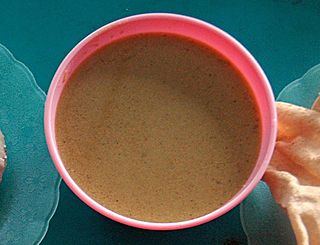




Maldivian cuisine, also called Dhivehi cuisine, is the cuisine of the Republic of Maldives. The traditional cuisine of Maldivians is based on three main items and their derivatives: coconuts, fish and starches.





Maldivian cuisine, also called Dhivehi cuisine, is the cuisine of the Republic of Maldives. The traditional cuisine of Maldivians is based on three main items and their derivatives: coconuts, fish and starches.
The coconut is used in the grated form, squeezed to obtain coconut milk, or as coconut oil in dishes that are deep-fried. The hunigondi is the traditional Maldivian implement used to grate the coconut. It is a long low chair with a serrated steel blade at its end. Grated coconut is used in dishes such as mas huni . [1]
The grated coconut may be alternatively soaked in water and squeezed in order to obtain coconut milk (kaashi kiru). Coconut milk is an essential ingredient in many Maldivian curries and other dishes. [2]
The fish of choice is mostly skipjack tuna, either dried or fresh. Other similar fish species that are part of the average Maldivian diet are little tunny (latti), yellowfin tuna (kanneli), frigate tuna (raagondi), bigeye scad (mushimas), wahoo (kurumas), mahi-mahi (fiyala) and mackerel scad (rimmas). These can be eaten boiled or processed.
Processed tuna (Maldives fish) is used as pieces or as shavings. In order to make curries, the raw or the still-soft processed tuna is cut into 1⁄2-inch-thick (13 mm) sections. Dry processed tuna is mainly used to make short eats (hedhika) called gulha, masroshi, kulhi bōkiba, kavaabu, bajiya (the local version of the Indian samosa), and fathafolhi. Mixed with coconut, onions and chili it is an essential Maldivian breakfast item, known as mas huni . Unlike Pacific islanders, Maldivians do not have a tradition of eating raw fish. [1]
The tuna-based thick brown paste known as rihaakuru is also an essential item in Maldivian cuisine. [3]
These are starches such as rice, which is eaten boiled or ground into flour, or tubers such as taro (ala), sweet potato (kattala), and cassava (dandialuvi), as well as fruits like breadfruit (bambukeyo) or screwpine (kashikeyo). Tubers and breadfruit are eaten boiled. The screwpine fruit is mostly eaten raw after having been cut into thin slices. [1]
The most important curry in the cuisine of the Maldives is cooked with diced fresh tuna and is known as mas riha . Kukulhu riha (chicken curry) is cooked with a different mixture of spices.
Vegetable curries in the Maldives include those that use bashi (eggplant), tora (Luffa aegyptiaca), barabō (pumpkin), chichanda (Trichosanthes cucumerina) and muranga faiy ( moringa leaves ), as well as green unripe bananas and certain leaves as their main ingredients. Pieces of Maldive fish are normally added to give the vegetable curry a certain flavor. Curries are usually eaten with steamed rice or with roshi. [1]

Malay cuisine is the traditional food of the ethnic Malays of Southeast Asia, residing in modern-day Malaysia, Indonesia, Singapore, Brunei, Southern Thailand and the Philippines as well as Cocos Islands, Christmas Island, Sri Lanka and South Africa.

Sri Lankan cuisine is known for its particular combinations of herbs, spices, fish, vegetables, rices, and fruits. The cuisine is highly centered around many varieties of rice, as well as coconut which is a ubiquitous plant throughout the country. Seafood also plays a significant role in the cuisine, be it fresh fish or preserved fish. As a country that was a hub in the historic oceanic silk road, contact with foreign traders brought new food items and cultural influences in addition to the local traditions of the country's ethnic groups, all of which have helped shape Sri Lankan cuisine. Influences from Indian, Indonesian and Dutch cuisines are most evident with Sri Lankan cuisine sharing close ties to other neighbouring South and Southeast Asian cuisines.

Garudhiya or Garudiya is a clear fish broth. It is one of the basic and traditional food items of Maldivian cuisine. The broth is based on tuna species found in the nation's ocean waters such as skipjack (kanḍumas or goḍa), yellowfin tuna (kanneli), little tunny (lațți), or frigate tuna (raagonḍi).

Rihaakuru is a tuna-based thick sauce. The color varies from light brown to dark brown. It is a traditional dish of Maldivian cuisine, consumed almost daily in every household in Maldives and in Minicoy since ancient times. Rihaakuru is produced as a by-product of the processing of tuna.

Maldives fish is cured tuna traditionally produced in Maldives. It is a staple of the Maldivian cuisine, Sri Lankan cuisine, and the cuisine of the Southern Indian states and territories of Lakshadweep, Kerala and Tamil Nadu, and in the past it was one of the main exports from Maldives to Sri Lanka, where it is known as umbalakaḍa (උම්බලකඩ) in Sinhala and masikaruvadu in Tamil. It is also produced in small scale using traditional methods in Lakshadweep Islands in India. It is known as massmin in Lakshadweep.
Goan cuisine consists of regional foods popular in Goa, an Indian state located along India's west coast on the shore of the Arabian Sea. Rice, seafood, coconut, vegetables, meat, bread, pork and local spices are some of the main ingredients in Goan cuisine. Use of kokum and vinegar is another distinct feature. Goan food is considered incomplete without fish.

Belizean cuisine is an amalgamation of all ethnicities in the nation of Belize and their respectively wide variety of foods. Breakfast often consists of sides of bread, flour tortillas, or fry jacks that are often homemade and eaten with various cheeses. All are often accompanied with refried beans, cheeses, and various forms of eggs, etc. Inclusive is also cereal along with milk, coffee, or tea.

Fijian cuisine has long consisted of primarily foraged and farm-grown food. Although rice, wheat, and tea all became staples during Fiji's colonial era, native Fijians still eat primarily tubers and coconuts. The cuisine of Fiji is known for its seafood and various green vegetables, including ''ota'', a young forest fern, and ''bele'', a plant that resembles spinach.

A great variety of cassava-based dishes are consumed in the regions where cassava is cultivated, and the ingredient is included many national or ethnic specialities.

Maldivians are an Indo-Aryan ethnic group and nation native to the historic region of the Maldive Islands, present day Republic of Maldives and the island of Minicoy in Union Territory of Lakshadweep, India. Maldivians share one culture and speak the Maldivian language, which is a member of the southern group of Indo-Aryan languages. For ethnographic and linguistic purposes as well as geopolitical reasons, anthropologists divide the Maldivian people into three subgroups.

Mas huni is a typical Maldivian breakfast, comprising tuna, onion, coconut, and chili. All ingredients are finely chopped and mixed with the grated meat of the coconut. This dish is usually eaten with freshly baked roshi (flatbread) and sweetened hot tea.

Mas riha is a fish curry of the Maldivian cuisine.

Khanom chin or Khanom jeen are fresh, thin rice noodles in Thai cuisine which are made from rice sometimes fermented for three days, boiled, and then made into noodles by extruding the resulting dough through a sieve into boiling water. Khanom chin is served in many kinds of stock: coconut milk, fish curry, and chilli.

Niue is an island in the Southern Pacific, mostly inhabited by Polynesians. The plantations are mostly filled with manioc, taro and breadfruit, but banana trees can be found. The wide range of exotic plants in Niue includes taros, pawpaw, coconuts, bananas, yams, cassavas and breadfruits: All are intensively used in the local cuisine.

Gulha is a typical and popular Maldivian short eat.

Seychellois cuisine is the cuisine of the Republic of Seychelles, an archipelago country consisting of 115 islands. Fish plays a prominent part in country's cuisine because of its location in the Indian Ocean. The Seychelles's cuisine has been influenced by African, British, French, Spanish, Indian and Chinese cuisines.

Kandu Kukulhu, also known as tuna curry, is a traditional Maldivian dish. Tuna fillets are rolled with spices and cooked in coconut milk.